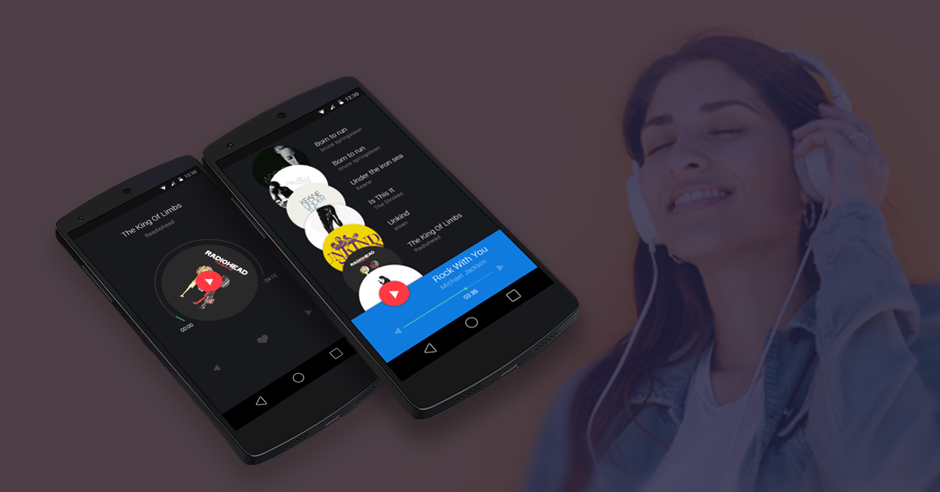Music streaming has come a long way from the days of downloading songs and storing them on devices. Today, with the rise of 5G and cloud technology, users can enjoy seamless music experiences like never before. These advancements have transformed the way we listen to music, offering faster streaming, better quality, and endless accessibility.
In this blog, we’ll explore how 5G and cloud technology are revolutionizing music streaming apps, making them more efficient, immersive, and accessible to users worldwide.
The Evolution of Music Streaming
Before diving into 5G and cloud technology, let’s take a quick look at how music streaming has evolved. If you are an entrepreneur looking for a music app development company or planning to create a Music App, leveraging these advanced technologies can set your platform apart in this competitive industry
- MP3 Downloads: Users had to download songs and store them on their devices, which took up space.
- Online Streaming (3G & 4G Era): Platforms like Spotify, Apple Music, and YouTube allowed users to stream music directly but required stable internet connections.
- 5G & Cloud Technology: The latest innovations enable instant, high-quality streaming without buffering or storage limitations.
Now, let’s understand how these technologies are changing the game.
5G Technology: A Game-Changer for Music Streaming
1. Ultra-Fast Streaming Without Buffering
5G offers blazing-fast internet speeds, significantly reducing buffering and lag. Whether users are streaming a high-quality song or watching a live concert, 5G ensures a smooth experience. This means:
- No delays while switching between tracks.
- Instant loading of music libraries.
- Uninterrupted live-streamed concerts.
2. High-Quality Audio Streaming
With higher bandwidth and lower latency, 5G allows music apps to stream high-resolution audio formats like FLAC and Dolby Atmos. Users can enjoy studio-quality sound without worrying about interruptions, making music more immersive than ever.
3. Enhanced Mobile Experiences
Most users listen to music on the go, and 5G makes mobile streaming effortless. Whether commuting, working out, or relaxing outdoors, they can access music instantly without worrying about weak network signals.
4. Improved Connectivity in Crowded Areas
5G networks handle high traffic better, ensuring stable connections even in crowded areas like concerts, festivals, and public transport hubs. This guarantees uninterrupted music streaming anywhere.
5. Faster Download Speeds
With 5G, users can download entire playlists and albums in seconds, making offline music access more convenient than ever before.
6. Seamless Integration with Smart Devices
5G enhances connectivity between music streaming apps and smart devices, such as speakers, headphones, and in-car systems, for a more immersive experience.
7. Enhanced Live Streaming for Artists
Musicians and DJs can live-stream their performances in ultra-HD with minimal latency, allowing fans to enjoy real-time, high-quality music experiences.
8. Reduced Battery Consumption
5G networks are designed to be more efficient, meaning music streaming apps consume less power, extending battery life on mobile devices.
9. AR & VR Music Experiences
5G enables augmented reality (AR) and virtual reality (VR) integration in music apps, offering interactive experiences such as virtual concerts and 360-degree music videos.
Cloud Technology: The Backbone of Modern Music Apps
While 5G handles fast streaming, cloud technology plays a crucial role to create a music app with storage for vast music libraries . Here’s how:
1. Unlimited Storage & Accessibility
Gone are the days of limited storage on devices. Cloud-based music apps allow users to access millions of songs without downloading them. For long-term data safety, many platforms rely on the best cloud storage with encryption, ensuring that user playlists and preferences remain secure while still being easily accessible.
- No need to delete songs to free up space.
- Seamless access across multiple devices.
- Personalized playlists saved securely in the cloud.
2. Smart Recommendations with AI
Cloud technology enables AI-powered recommendations, analyzing user preferences to suggest personalized playlists. This makes discovering new music easier and more enjoyable.
3. Offline Mode & Syncing
Even though cloud-based music apps rely on the internet, they also offer offline mode. Users can download songs temporarily, ensuring uninterrupted playback even without an internet connection.
The Future of Music Streaming with 5G and Cloud
1. Live Virtual Concerts in High Definition
With 5G’s speed and cloud’s scalability, artists can host virtual concerts in ultra-HD without technical issues. Users can enjoy a real-time immersive experience, feeling like they’re part of the event.
2. Interactive & Social Features
Modern music apps integrate social features like real-time song sharing, collaborative playlists, and live chat during streaming sessions. Thanks to 5G and the cloud, these interactions are smoother and more engaging.
3. Smart Devices & Wearable Compatibility
From smart speakers to smartwatches, music streaming apps are expanding their reach. With 5G and cloud connectivity, users can control their music seamlessly across different devices with voice commands or gestures.
4. Ultra-Personalized AI-Driven Recommendations
With the cloud processing vast amounts of data in real-time and 5G ensuring instant access, AI-driven music apps can offer hyper-personalized recommendations based on mood, location, and listening habits.
5. Zero-Latency Music Collaboration
Musicians and producers can collaborate from different locations without delay. Cloud-based digital audio workstations (DAWs) and 5G connectivity allow seamless real-time music production and live jamming sessions.
6. Offline Streaming with Cloud Sync
5G and cloud storage eliminate the need for large offline downloads. Users can stream cached versions instantly with minimal buffering, even in low-network areas.
7. Augmented Reality (AR) & Virtual Reality (VR) Music Experiences
AR and VR concerts, immersive music videos, and holographic performances will be more accessible. Fans can interact with virtual avatars of artists in real time.
8. Spatial & Lossless Audio Streaming
With 5G’s high bandwidth, platforms can stream lossless and spatial audio (such as Dolby Atmos and Sony 360 Reality Audio) without lag, delivering a studio-quality listening experience.
9. AI-Powered Voice Assistants for Music Discovery
Voice commands will play a bigger role in music streaming. AI-powered assistants can curate playlists, suggest new tracks, and even mix songs dynamically based on user preferences.
10. Cloud-Based Music Libraries & Cross-Platform Access
Users won’t need to store music files on their devices. With cloud sync, they can access their libraries instantly across different platforms and devices.
Conclusion
5G and cloud technology are reshaping the world of music streaming, making it faster, smarter, and more immersive. With ultra-fast streaming, high-quality audio, unlimited storage, and AI-driven recommendations, music lovers now have the ultimate listening experience at their fingertips. As technology continues to evolve, we can expect even more exciting features in music streaming apps.






